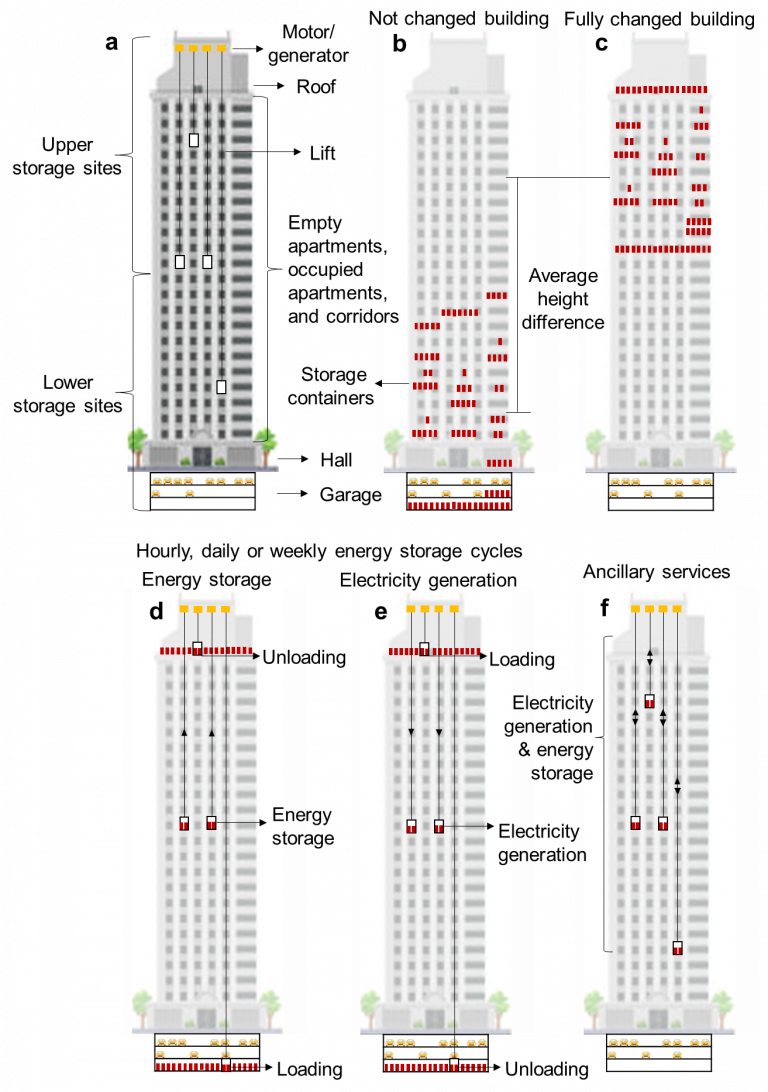Reviewed by Alex SmithMay 31 2022
There is an increasing need for energy storage technologies to guarantee that electricity supply and demand are balanced correctly. This comes with the rapid decrease in the costs of renewable energy generation, like solar and wind power.
 Lift Energy Storage Technology (LEST) (a) system components, (b) not changed and (c) fully charged building, (d) operating on energy storage, (e) electricity generation, or (f) ancillary services mode. Image Credit: Hunt et al. (2022).
Lift Energy Storage Technology (LEST) (a) system components, (b) not changed and (c) fully charged building, (d) operating on energy storage, (e) electricity generation, or (f) ancillary services mode. Image Credit: Hunt et al. (2022).
Scientists from International Institute for Applied Systems Analysis (IIASA) have developed a new energy storage idea that could convert tall buildings into batteries to enhance the power quality in urban settings.
The world’s capacity to produce electricity from wind turbines, solar panels, and other renewable technologies has been on a constant increase for the past few years, and global renewable electricity capacity has been anticipated to increase additionally by over 60% from 2020 levels by 2026.
This is comparable to the present total global power capacity of fossil fuels and nuclear combined. As per the International Energy Agency, renewables are indeed set to constitute nearly 95% of the increase in global power capacity by 2026, with solar PV alone offering more than half.
But, the changeover to a low- or zero-carbon society needs novel solutions and a different approach to storing and consuming energy compared to conventional energy systems.
In their study reported in the Energy journal, IIASA scientists suggest a novel gravitational-based storage solution that makes use of lifts and empty apartments in tall buildings that has the ability to store energy.
This actual concept has been called the Lift Energy Storage Technology (LEST) by the authors. It has the potential to store energy by lifting wet sand containers or other high-density materials, which are remotely transported in and out of a lift with separate trailer devices.
LEST is an intriguing option since lifts have already been installed in high-rise buildings, implying there is no need for extra investment or space occupancy. However, instead of making use of what there already is, a different approach is to make extra value for the power grid and the building owner.
I have always been fascinated with topics involving potential energy, in other words, generating energy with changes in altitude, such as hydropower, pumped-storage, buoyancy, and gravity energy storage. The concept of gravity energy storage has also recently received significant attention in the scientific community and start-ups.
Julian Hunt, Study Lead Author and Researcher, Sustainable Service Systems Research Group, International Institute for Applied Systems Analysis
Hunt added, “The concept of LEST came to me after having spent a considerable amount of time going up and down in a lift since recently moving into an apartment on the 14th floor.”
The authors feel that the main difficulty in making a gravity energy storage solution feasible is the power capacity cost.
The most significant advantage of LEST is that the power capacity has already been installed in lifts along with regenerative braking systems. There are more than 18 million lifts in operation throughout the world.
Also, many of these spend a considerable amount of time remaining idle. The concept is that when the lifts are not being utilized to transport people, they can be utilized to store or produce electricity.
As far as any new system is concerned, there are still some details that need to be refined before the system can be deployed. This is inclusive of finding a location to store the weights and hence the system depends on at the top of the building when the system is fully charged, and at the bottom of the building when the system has been discharged.
Empty corridors or apartments can be feasible options in this context. One more consideration is the ceiling bearing capacity of present buildings where the system has been installed, that is, the total mass in kilograms per square meter that the ceiling could support without collapsing.
Having the potential to store energy where electricity consumption is huge, like in cities, will largely benefit the energy grid and LEST can offer low-cost and decentralized ancillary services. This could in turn enhance the power quality in an urban setting.
Environmentally friendly and flexible storage technologies like LEST are set to become more and more valuable to society in a future where a large share of its electricity comes from renewables.
Behnam Zakeri, Study Co-Author and Researcher, Integrated Assessment and Climate Change Research Group, International Institute for Applied Systems Analysis
Zakeri added, “Therefore, policymakers and power system regulators need to adopt strategies to incentivize end users, in this case, high-rise buildings, to share their distributed storage resources, such as LEST, with the central grid. The coordinated utilization of such distributed resources alleviates the need for investment in large-scale central storage systems.”
Journal Reference:
Hunt, J. D., et al. (2022) Lift Energy Storage Technology: A solution for decentralized urban energy storage. Energy. doi.org/10.1016/j.energy.2022.124102.